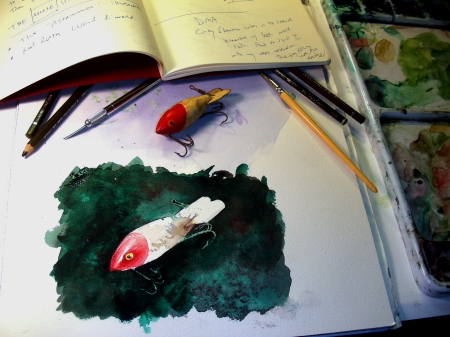“He painted far into the night with an air of great seriousness,” said Finkelstein. “He would go to the other side of his loft and stare fixated. Then suddenly he would come alive and then step back again. ‘Whoever he is, he must be one of the most serious artists,’ we said to each other.” According to Betsy Egan Duhrsen, “Bill just worked. He worked and worked.” No matter how late the discussions went at the Waldorf, no matter what tensions arose in his personal life, de Kooning continued to work with the relentless intensity of one who strives always to reach the unattainable.
Mark Stevens and Annalyn Swan, de Kooning: An American Master.
After a restless night when I couldn’t shut down my brain and go to sleep until nearly 3 a.m., I awoke without an alarm around 7:00, rose, made breakfast, and brought it out into the Cave to enjoy the cool morning. While eating, I watched a VHS tape documentary of Willem de Kooning from the “Strokes of Genius” series. I became so absorbed with it, that I pulled my biography (cited above) that I had read in its entirety back in 2004, and began re-reading the chapter that covered his emergence in the fall of 1948. One of the biographical notes that has stuck with me since my reading of this book concerns the drive of de Kooning that persisted for decades. In earlier blogs, I have poked fun at his tendencies to spend more time looking at his work than actual painting, and then his constant revision (actually, erasure!) of work he had spent several hours putting together.
I rose from my reading chair, completely blank about what to do next, only that I needed to do something next. So, I pulled out the vintage tackle box lent to me by a dear friend, pulled out this old wooden Bomber plug, and decided to put it on a dark field of green, instead of the white that I had always used before and found unsatisfactory. Because of the layers of wet-on-wet, the painting is staying pretty soupy, disallowing me to do tight pencil work. So I continue to read from this biography of de Kooning.

On this Easter morning, I post with amusement this illustration which has been my inspiration for over twenty years. The illustration, known as the Flammarion engraving, first appeared in Camille Flammarion’s 1888 book L’atmosphère: météorologie populaire (“The Atmosphere: Popular Meteorology”). I have always loved the look of the inquisitive pioneer, pushing past the veil, to the primal workings of the world. I have had this picture in my mind for over twenty years, every time I think of someone (or myself) trying to push into a new world, in discovering a new style, a new idea, a new pursuit.
I post it today, honoring the memory of Willem de Kooning’s endeavors during those late New York nights in his Fourth Avenue studio, trying to figure out what to do next in painting. And I keep it before me today as I paint, trying to figure out what to pursue next. When in doubt, paint.
Thanks for reading.

March 31, 2013 at 5:58 pm |
I agree! Great advice and nice work.
LikeLike
April 1, 2013 at 7:15 am |
Thank you! I’m trying to follow my own advice 🙂
LikeLike